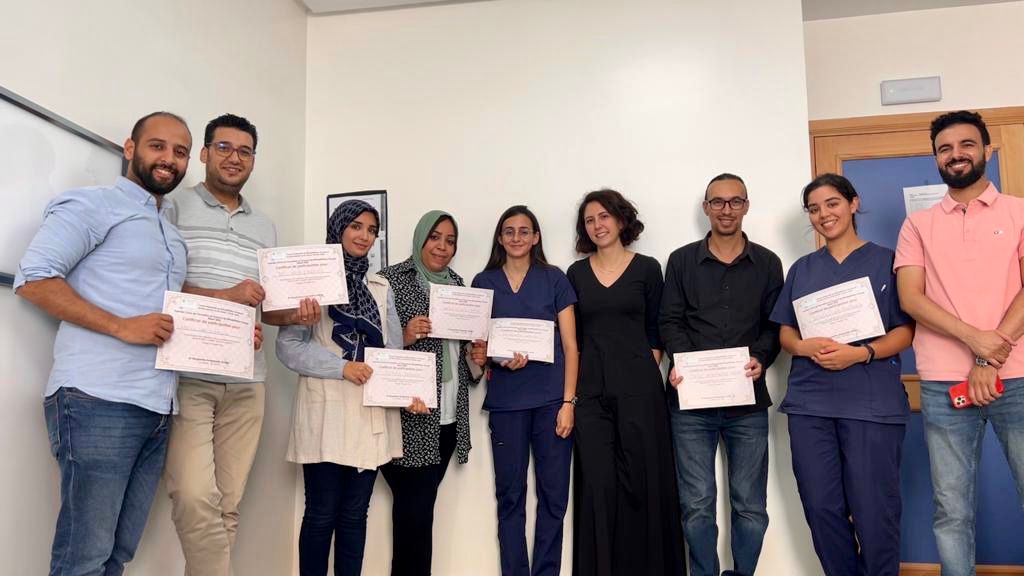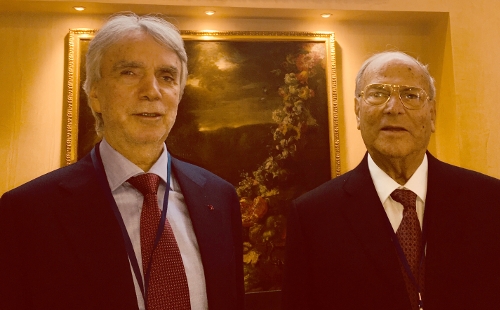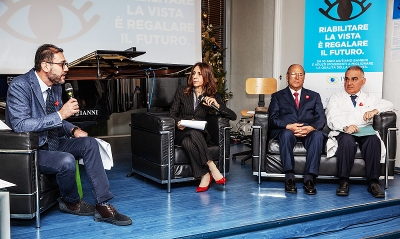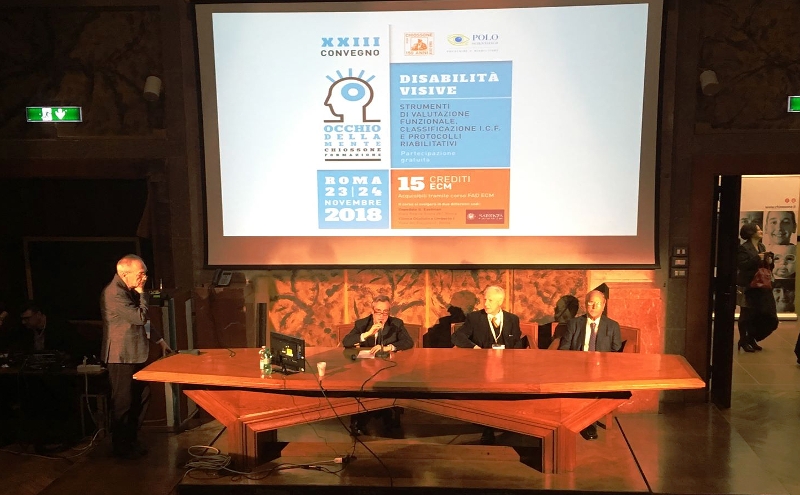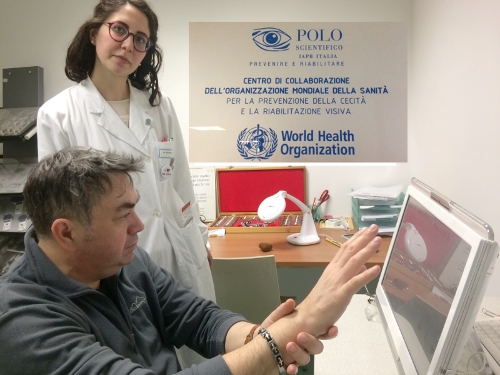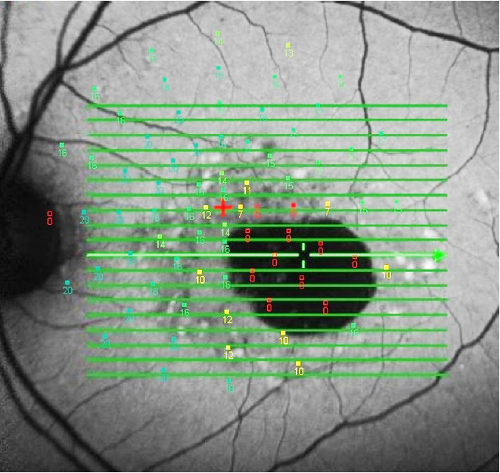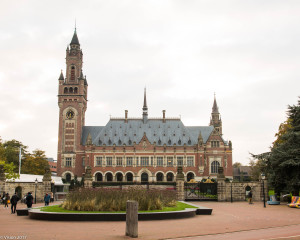“Psychological intervention in the field of low vision”, an event hosted by the Order of Psychologists of Lazio, 22 March
Continue readingThe International Vision Rehabilitation Standards arrive in Morocco
Vision rehabilitation presented at SOI congress
On November 29th, 2018 two symposia of the National Centre and IAPB Italy have been held at the 98th Congress of the Italian Society of Ophthalmology

From neuroplasticity to neurostimulation, including vision rehabilitation at home and the progress of patients who have received a retinal prosthesis implant (the so-called “bionic eye” or, more accurately, the artificial retina). These are the main topics that were addressed during the Symposium of the National Centre – it took place in Rome on 29th November, 2018 – as part of the 98th Congress of the Italian Society of Ophthalmology. [[From 28th November to 1st December, 2018. The 150th anniversary of SOI will be celebrated in 2019.]]
The International Agency for the Prevention of Blindness-IAPB Italy also hosted its own conference, a symposium concerning the appearance of the visually impaired: prosthetic strategy and surgery (eye socket, plastic surgery and diseases of the ocular adnexa). We discussed the prescription of ocular prosthesis as well as the psychological aspects of aesthetic damage at ocular level.
The President of IAPB Italy, Mr. Giuseppe Castronovo, opened the proceedings, starting from his own experience and stated that “ocular prostheses are crucial, also for a person’s social life”.
He was followed by the Vice President, Mr. Michele Corcio, who briefly outlined the history of the blind and said that “in the ’70s and’ 80s the need was felt to publicly show blindness” in a period of political, social and cultural protest. This time of “realism” with regard to disability (that is to say, showing it in an unfiltered way), was followed by a “period of concealment of blindness” (when dark glasses were worn even indoors). Yet, Corcio observed:
There is a middle way between a “raw” and “violent” exposure of blindness and its concealment. The ocular prosthesis is important: we must neither hide nor exhibit our disability, but be ourselves.

Dr. Stefania Fortini, psychologist and Deputy Director of the National Centre highlighted that…
the psychological aspect considerably affects social acceptance and, therefore, quality of life. […] We must never fail to evaluate the physical and emotional well-being of patients, in order to determine the ones who need further support.
At the end of her speech, Dr. Fortini said that “ophthalmologists are not fully aware of the physical and emotional problems faced by patients who are suffering from ocular aesthetic damage”.
Within the broad framework of the SOI congress – mainly geared towards ophthalmologists and other professionals in the sector – not only conferences, but also workshops, verbal communications and posters were featured. Traditional themes of ophthalmology were addressed, along with cutting edge innovative themes. It was also possible to watch a live surgery, as usual.
 It was an opportunity for discussion and further training on major themes, such as cataracts, the cornea and the ocular surface, eye tumors, glaucoma, uveitis, neuro-ophthalmology, refraction, medical and surgical retina, refractive surgery [[laser surgery for the correction of refractive errors, such as myopia, hypermetropia and astigmatism]] and diagnostic procedures. Four intense days, involving complex organization, which was able to offer the widest and most extraordinary choice of scientific topics to every participant.
It was an opportunity for discussion and further training on major themes, such as cataracts, the cornea and the ocular surface, eye tumors, glaucoma, uveitis, neuro-ophthalmology, refraction, medical and surgical retina, refractive surgery [[laser surgery for the correction of refractive errors, such as myopia, hypermetropia and astigmatism]] and diagnostic procedures. Four intense days, involving complex organization, which was able to offer the widest and most extraordinary choice of scientific topics to every participant.
THE PARTNERSHIP BETWEEN IAPB ITALY AND SOI
 Prevention activities have been further reinforced thanks to the close collaboration between IAPB Italy, SOI and the Insieme per la Vista Foundation. Together they continue to offer free eye exams to people who have never had their eyes checked by an ophthalmologist (the initiative was launched on World Sight Day, which was celebrated on 11th October, 2018.) The campaign, based on comprehensive eye exams, has been dubbed “Save Sight” and was further promoted during the SOI congress, with more ophthalmologists signing-up to it.
Prevention activities have been further reinforced thanks to the close collaboration between IAPB Italy, SOI and the Insieme per la Vista Foundation. Together they continue to offer free eye exams to people who have never had their eyes checked by an ophthalmologist (the initiative was launched on World Sight Day, which was celebrated on 11th October, 2018.) The campaign, based on comprehensive eye exams, has been dubbed “Save Sight” and was further promoted during the SOI congress, with more ophthalmologists signing-up to it.
Read the SOI Program (98th National Congress)
Reference source: SOI
10th anniversary of the National Centre
On 13th December, doctors and low vision patients spoke about their experiences at the Gemelli Hospital, Rome, Italy: a day of celebration with free eye exams
On Thursday 13th December 2018 we celebrated the 10th anniversary of the National Centre of Services and Research for the Prevention of Blindness and Vision Rehabilitation of the Visually Impaired, with personal stories shared by its protagonists: from ophthalmologists to visually impaired people. It was a day of celebration: many stories and personal life experiences were shared by people of all ages, from children to the elderly, in the presence of their families.
 Within this broad framework, free eye exams were performed. People who wanted to have their eyes examined simply had to go to the help desk that had been set up in the hall, by the entrance to the Gemelli Hospital (4th floor), with no need of a prior booking. Examinations were performed by ophthalmologists and orthoptists from 10 to 12:30 a.m. in two dedicated areas: one reserved for children and the other for adults.
Within this broad framework, free eye exams were performed. People who wanted to have their eyes examined simply had to go to the help desk that had been set up in the hall, by the entrance to the Gemelli Hospital (4th floor), with no need of a prior booking. Examinations were performed by ophthalmologists and orthoptists from 10 to 12:30 a.m. in two dedicated areas: one reserved for children and the other for adults.
The various events of the day – which were moderated by the journalist Nicoletta Carbone of the Italian Radio 24, and were assisted by Dr. Filippo Amore – started at 10 a.m: after a brief presentation, there was also a welcoming speech by Mr. Giuseppe Castronovo, President of IAPB Italy, founder and current President of the National Centre.

The National Centre is a wonderful initiative, which is crucial for vision rehabilitation and blindness prevention. We don’t want anybody to become blind: neither children, nor adults or elderly people.
Among the day’s speakers were Ms. Giuseppina Rizzo (from the Ministry of Health), Prof. Emilio Balestrazzi, former Director of the Ophthalmology Clinic of Gemelli Hospital, as well as its current Director, Prof. Aldo Caporossi.
The international relevance of the National Centre – as unique WHO Collaborating centre for vision rehabilitation since 2013 – and vision rehabilitation of children were outlined thanks to the presentations by the Director of the National Centre, Dr. Filippo Amore, the ophthalmologist Dr. Romina Fasciani (Gemelli Hospital)and Prof. Eugenio Mercuri (Director of the Child Neuropsychiatry Department of the Gemelli Hospital).
 The second part of the morning featured speeches by Ms. Stefania Fortini (psychologist and psychotherapist, Deputy Director of the National Centre), Dr. Daniela Ricci (child neuropsychiatrist) and Dr. Simona Turco (ophthalmologist of the National Centre). The day was enriched not only by live musical performances, but also by an exhibition of paintings and sculptures made by patients.
The second part of the morning featured speeches by Ms. Stefania Fortini (psychologist and psychotherapist, Deputy Director of the National Centre), Dr. Daniela Ricci (child neuropsychiatrist) and Dr. Simona Turco (ophthalmologist of the National Centre). The day was enriched not only by live musical performances, but also by an exhibition of paintings and sculptures made by patients.
The Eye of the Mind, experts gather in Rome
A conference on sight prevention and vision rehabilitation for ophthalmologists and orthoptists was held in Rome between 23-24 November 2018
 “The Eye of the Mind” is the title of the Conference on vision rehabilitation that was held on 23rd November, 2018, at the George Eastman Dental Hospital in Viale Regina Elena 287, Rome. The meeting continued on the following day at the Ophthalmology Clinic of the Umberto I Polyclinic Hospital.
“The Eye of the Mind” is the title of the Conference on vision rehabilitation that was held on 23rd November, 2018, at the George Eastman Dental Hospital in Viale Regina Elena 287, Rome. The meeting continued on the following day at the Ophthalmology Clinic of the Umberto I Polyclinic Hospital.
The first day was dedicated, in particular, to neuro-ophthalmological issues in children and adults (including brain plasticity), while presentations on the second day focused more on technical-rehabilitative aspects, and on the protocols (rehabilitation procedures) and the assessment of vision disabilities.
The experts who were invited to speak hailed from numerous institutions, such as the A. Gemelli Polyclinic Hospital in Rome, the National Centre for Vision Rehabilitation, the Sapienza University of Rome, the David Chiossone Institute in Genoa, the Gaslini Hospital, the World Health Organization, the Pavia Eye Clinic, etc.
Mr. Giuseppe Castronovo, President of IAPB Italy, opened the event on 23rd November, together with Prof. F. Cruciani, Prof. A. Lambiase (Sapienza University) and the President of the Chiossone Institute, Prof. C. Cassinelli. In his speech, Mr. Castronovo said:
Sight and rehabilitation are two wonderful words. Sight gives us freedom and autonomy: we must do everything we can to avoid young people, adults and the elderly losing it.
In a subsequent working session, Dr. Simona Turco – an ophthalmologist who works at the National Centre founded by IAPB Italy at the A. Gemelli Polyclinic Hospital – presented a home-based vision rehabilitation program (Eye Fitness) that was developed by the National Centre, which uses an innovative IT platform.
On 24th November, the case studies of a number of adults and visually impaired children who had followed a vision rehabilitation path, in particular at the National Centre, were also presented at the Aula Magna of the Ophthalmology Clinic of the Sapienza University.
The training course was free of charge and catered primarily to doctors and orthoptists [Participants were awarded 15 CME credits]. It was organized by the Chiossone Institute – its 150th anniversary is celebrated this year – in collaboration with the National Centre.
National Centre, collaboration with the WHO renewed
The agreement is valid until May 2020: from visual rehabilitation to prevention, to psychological assistance to the visually impaired
 It is a one of a kind World Health Organization (WHO) Collaborating Centre in the field of blindness prevention and visual rehabilitation. We’re talking about the National Centre, which has just renewed an agreement with the WHO for a further three years (until May 1, 2020).
It is a one of a kind World Health Organization (WHO) Collaborating Centre in the field of blindness prevention and visual rehabilitation. We’re talking about the National Centre, which has just renewed an agreement with the WHO for a further three years (until May 1, 2020).
What is our National Centre
The National Centre of Services and Research for the Prevention of Blindness and Vision Rehabilitation of the Visually Impaired – which is based at the A. Gemelli Polyclinic Hospital in Rome – works with people who are affected by a significant reduction in vision: thanks to vision rehabilitation, they can improve their quality of life. The National Centre can count on a multidisciplinary team, consisting of various professionals, such as ophthalmologists, orthoptists, psychologists, orientation and mobility instructors, etc. (Read more) 
More psychology and rehabilitation for the visually impaired
The visually impaired are generally trained to make the most of their residual vision and receive psychological support too. [[thanks to a holistic approach that considers the person as a whole, following scientifically validated procedures]]. Once rehabilitation has started [[reading exercises, use of paracentral vision in case of maculopathy, etc.]], in some cases patients can continue their training at home on their computer. This is known as home telerehabilitation, which the National Centre has developed thanks to the dedicated work of several specialists.
The new objectives of the WHO Collaborating Centre also include a new version of an international psychological questionnaire. In essence, those who go to an accredited centre for visual impairment and rehabilitation can receive, in the future, a possible diagnosis of depression/anxiety related to a significant reduction in vision. In this case rehabilitative therapies can be “modeled” on the psychological state of the patient.
The National Centre is a state-of-the-art hypovision centre founded and managed by the International Agency for the Prevention of Blindness-IAPB Italy. Opened at the end of 2007, it has been operating since 2008. It became a WHO Collaborating Centre in 2013.
Sources: WHO, IAPB
Vision rehabilitation, a worldwide overview
REPORT ON CONSENSUS CONFERENCE PROMOTED IN 2015 BY WHO TOGETHER WITH IAPB AND THE NATIONAL CENTRE WAS PUBLISHED
 More ophthalmological data, more collaboration between professionals, integrated rehabilitative paths to teach visually impaired people to see better. The International Agency for the Prevention of Blindness-IAPB Italy and WHO have joined together to identify common standards for vision rehabilitation worldwide.
More ophthalmological data, more collaboration between professionals, integrated rehabilitative paths to teach visually impaired people to see better. The International Agency for the Prevention of Blindness-IAPB Italy and WHO have joined together to identify common standards for vision rehabilitation worldwide.
Even though today there are no internationally shared standards, specific steps are being taken towards this aim.
These issues were addressed in Rome – from 12th to 15th December 2015 – thanks to an International Conference promoted by the WHO and coordinated by the National Centre of Services and Research for the Prevention of Blindness and Rehabilitation of the Visually Impaired [[founded by IAPB Italy at the A. Gemelli Hospital in Rome, a WHO Collaborating Centre]], which saw experts from around the world participate in a four-day meeting, including ophthalmologists, epidemiologists, WHO regional managers, etc.
A Report was finally published that details the contents of this Consensus Conference in 2017. The Report reads:
This document is the outcome of a consultative process to elaborate international standards on vision rehabilitation. The process, which began in 2014, culminated in the International Consensus Conference on Vision rehabilitation […].
Among other things it reminds us that:
● a visually impaired person should follow a multidisciplinary rehabilitative path that is focused on the person, not merely on clinical aspects;
● vision rehabilitation should be commensurate to individual objectives and any risks that are to be assumed;
● it is necessary to have better collaboration and cooperation, as well as good communication, among all the professionals involved in the rehabilitative path;
● the lack of data at national level on the requirements related to vision rehabilitation demands the collection of new data to identify the needs of the population and ascertain whether these needs are being satisfied.
Report of Consensus Conference 2015
Main sources: WHO, IAPB
Visual rehabilitation of patients with Stargardt’s disease
The National Centre and the Ophthalmology Clinic of A. Gemelli polyclinic have completed an in-depth analysis of the retina of visually impaired patients, also studying their reading abilities
 Consider a disease such as Stargardt’s maculopathy. People who suffer from it have great difficulties in reading, are dazzled by sunlight and their visual abilities progressively weaken in their youth and over their working life, in particular, at the centre of the visual field.
Consider a disease such as Stargardt’s maculopathy. People who suffer from it have great difficulties in reading, are dazzled by sunlight and their visual abilities progressively weaken in their youth and over their working life, in particular, at the centre of the visual field.
What can be done? Today, there is no known cure, as Stargardt’s maculopathy is a genetically transmitted retinal dystrophy, but patients can learn to make the most of their residual visual skills, regain self confidence and improve their quality of life. All this thanks to visual rehabilitation.
Conference on low vision in The Netherlands
FROM 25TH TO 29TH JUNE 2017, WORLD EXPERTS GATHERED IN THE HAGUE FOR THE 12TH INTERNATIONAL CONFERENCE ON LOW VISION AND REHABILITATION. OUR NATIONAL CENTRE ATTENDED THE EVENT
 Vision rehabilitation of the visually impaired is a global human right. This was the central theme of the 12th International Conference on low vision research and rehabilitation, which was inaugurated on the 25th June 2017, and continued until the 29th June, in The Hague.
Vision rehabilitation of the visually impaired is a global human right. This was the central theme of the 12th International Conference on low vision research and rehabilitation, which was inaugurated on the 25th June 2017, and continued until the 29th June, in The Hague.
LOW VISION: A DRAMATIC IMPACT ON THE QUALITY OF LIFE
A significant reduction of visual abilities has a dramatic impact on lives and the visually impaired risk encountering difficulties in all aspects of their daily routines, including serious limitations in their social life participation and interaction with others.
Low vision is often associated with depression, emotional stress and a reduced quality of life. Many visually impaired people are elderly and are generally affected by at least one illness (often chronic). “The goal of low vision rehabilitation – the organizers write – is to enhance the ability of the patient’s remaining vision”.
Among the participants at the Dutch event were the Department of Ophthalmology and low vision research of the VU University Medical Center of Amsterdam and a large part of the scientific academic community that operates in this field. The European Society for low vision research and rehabilitation and its Dutch branch also attended the event.
OUR NATIONAL CENTRE BETWEEN REHABILITATIVE STANDARDS AND TELEREHABILITATION
“OMS standards for visual rehabilitation: a new perspective”: this is the title of the report presented by Filippo Amore, director of The National Centre of Services and Research for the Prevention of Blindness and Rehabilitation of the Visually Impaired, on 29th June, 2017. Such standards must not be considered suitable for everybody, but proportionally, for instance, according to the level of socio-economic development of a country or specific area.
 Among the numerous initiatives, we recall those of June 28th, relating to the posters dedicated to “Automation, information technology and e-health.” Among these, we’d like to mention the poster designed by the National Centre team, dedicated to the data collected during rehabilitation activities (over 900 patients between January 2013 and December 2016) and analyzed in an electronic format.
Among the numerous initiatives, we recall those of June 28th, relating to the posters dedicated to “Automation, information technology and e-health.” Among these, we’d like to mention the poster designed by the National Centre team, dedicated to the data collected during rehabilitation activities (over 900 patients between January 2013 and December 2016) and analyzed in an electronic format.
Valeria Silvestri (orthoptist of the National Centre) focused her attention on evaluation methods within the telerehabilitation program for the visually impaired. The National Centre has in fact started a hi-tech remote rehabilitative path thanks to which, after the start of the rehabilitative program at the Gemelli Polyclinic in Rome, patients can continue by themselves from home, by doing specific exercises on the computer. Their results are then evaluated remotely by a professional of the National Centre.
Main source: Vision2017
The problem of teenage smoking and overweight in Italy
WHO Europe presented a new report: Italy has the second highest life expectancy. Experts and politicians met up in Rome from 17th to 20th September
 Stop smoking, it could “cloud” your health. Despite the written warning on cigarette packets in Italy that “smoking increases the risk of blindness”, Italian teenagers seem to turn a blind eye, so to speak, to this kind of cautionary advice. In a meeting held in Rome from 17th to 20th September 2018, which was opened by the Italian Prime Minister, Giuseppe Conte, WHO Europe presented an alarming Report Italian teenagers are the ones who smoke the most in Europe.
Stop smoking, it could “cloud” your health. Despite the written warning on cigarette packets in Italy that “smoking increases the risk of blindness”, Italian teenagers seem to turn a blind eye, so to speak, to this kind of cautionary advice. In a meeting held in Rome from 17th to 20th September 2018, which was opened by the Italian Prime Minister, Giuseppe Conte, WHO Europe presented an alarming Report Italian teenagers are the ones who smoke the most in Europe.




